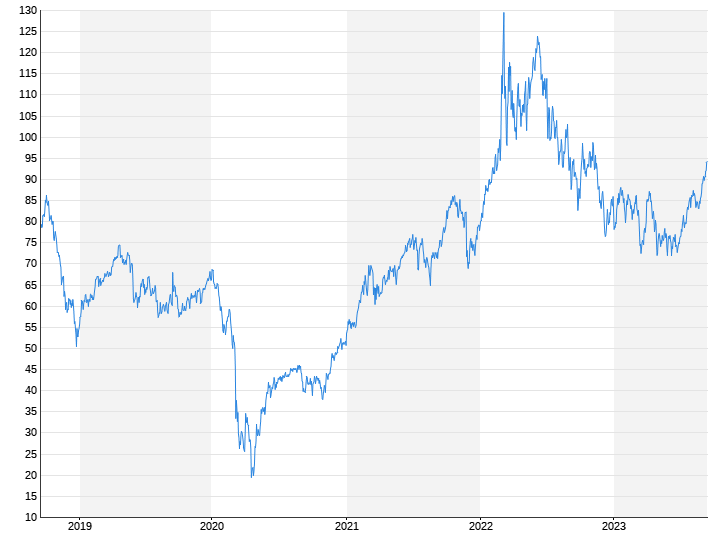Those who are said to be dead live longer
How close is peak oil?
By Victoria Robertz
September 17, 2023, 5:50 p.m
Listen to article
This audio version was artificially generated. More info | Send feedback
But now for real: the International Energy Agency predicts that the maximum demand for fossil fuels will be reached before 2030. This is due to three global trends that are gathering pace.
The peak of global oil production, “Peak Oil”, has come into view so often in the past that it can now be called infamous. The first forecasts appeared in the 1970s, when the USA had reached its provisional maximum production, then again with the oil price peaking during the 2008 financial crisis, and most recently in the years from 2014, when the oil price fell sharply.
In fact, the apex that is supposed to bring the oil market to its end has not yet been reached. But now the International Energy Agency (IEA) is making a new forecast: it should happen before the end of this decade. Really this time?
In its World Energy Outlook, to be published next month, the IEA shows that the all-time high could be reached not only for oil production before 2030, but also for natural gas and coal (“peak gas” and “peak coal”). “This is the first time this decade that a peak in demand for any fuel has become apparent – earlier than many expected,” writes Fatih Birol, chairman of the IEA, in the Financial Times. Last year the peak was estimated at “around 2030”. But since then, according to the IEA, several trends have accelerated: low-emission mobility, energy efficiency and the advancement of technologies.
These trends are global, but China in particular plays an important role in their development. On the one hand, the country is investing heavily in alternatives such as solar, wind and nuclear energy. Renewable energies could soon be more worthwhile than coal for what is currently the world’s largest coal consumer. On the other hand, China was an early adopter of electromobility, both for cars and vans. Leading Chinese oil refiner Sinopec recently announced that China would reach peak fuel demand this year – two years earlier than previously thought. That’s crucial because China has been the biggest driver of refined oil products like gasoline and diesel over the past two decades. For a company whose business model is based on exactly this, this is a clear statement.
Climate benefits
IEA Chairman Birol’s announcement that the world is “on the threshold of a historic turning point” is also clear. Christoph Weber, holder of the chair for energy economics at the University of Duisburg-Essen, believes the forecast is plausible. “The demand for fossil fuels will decrease and the supply will have to adapt to this,” he explains to “Capital”. One driver is of course climate protection, in the area of heating we have been gaining more and more distance from oil for many years and in the mobility sector the demand for electric vehicles is growing.
The climate is not only the driver of the change, but also the biggest beneficiary when fossil fuels reach their peak. The IEA expects that the peak of global greenhouse gas emissions is approaching, as early as the middle of this decade. Birol emphasizes that the 1.5 degree target will not be achieved for this reason alone. To achieve this, more consistent political measures are necessary.
The course of the decline in oil, gas and coal could also differ depending on the region. While oil consumption is expected to decline more quickly in more developed countries, it could still rise in others. Overall, the decline is unlikely to be linear. “Although fossil fuels will structurally peak this decade, there may still be spikes, dips and plateaus on the way down,” explains Birol. “For example, heat waves and droughts can lead to a temporary increase in coal demand by driving up electricity consumption while reducing hydropower production.”
Scientist Weber also clarifies that the decline after reaching the peak is not necessarily irreversible, as assumed in the peak oil theory. “This theory has long been controversial in professional circles and has been clearly refuted for North American oil production,” he says. “If a peak is reached soon due to weaker demand, a reversal would still theoretically be possible.”
“Downward tendency”
However, he considers it unlikely that this will happen. In his opinion, oil prices could still rise in the next two years because the demand is there and investments have been renewed due to the limitation of Russian gas deliveries. “But then I expect a downward trend,” says Weber. “Available supply will not be a limiting factor and easing demand pressures suggest a decline in prices.”
For oil and gas companies, this means they have to reassess the market sooner than expected. However, the major oil producing nations such as Saudi Arabia and the United Arab Emirates show that they are increasingly preparing for this development. The income from oil sales is increasingly flowing into other areas, for example tourism, the solar and hydrogen industries and the chemical industry. This fits with the current interest of the oil company Abu Dhabi National Oil in taking over the German plastics specialist Covestro.

